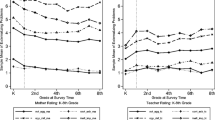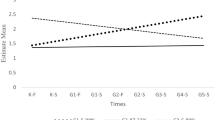Abstract
Internalizing and externalizing behaviors are heritable, and show genetic stability during childhood and adolescence. Less work has explored how genes influence individual differences in developmental trajectories. We estimated ACE biometrical latent growth curve models for the Teacher Report Form (TRF) and parent Child Behavior Checklist (CBCL) internalizing and externalizing scales from ages 7 to 16 years in 408 twin pairs from the Colorado Longitudinal Twin Study. We found that Intercept factors were highly heritable for both internalizing and externalizing behaviors (a2 = .61–.92), with small and nonsignificant environmental influences for teacher-rated data but significant nonshared environmental influences for parent-rated data. There was some evidence of heritability of decline in internalizing behavior (Slopes for teacher and parent ratings), but the Slope genetic variance was almost entirely shared with that for the Intercept when different than zero. These results suggest that genetic effects on these developmental trajectories operate primarily on initial levels and stability, with no significant unique genetic influences for change. Finally, cross-rater analyses of the growth factor scores revealed moderate to large genetic and environmental associations between growth factors derived from parents' and teachers' ratings, particularly the Intercepts.




Similar content being viewed by others
Notes
Scores at ages 7, 8 (in teacher), and 9 did not predict missingness at later time points (all p >. 055).
This model produced a Heywood case: in the DZ group, the cross-twin residual correlation for year 15 was greater than 1.0. We bound this residual correlation to be lower than 1.0 in the final model.
These models did not include year-specific cross-rater residual correlations because in initial models including them, none were significant for externalizing (all ps > .082), and only one was significant for internalizing (at age 12; r = .26, p = .012). Thus, for parsimony, we dropped all residual correlations.
References
Achenbach T (1991a) Manual for the Child Behavior Checklist/4-18 and 1991 profile. University of Vermont, Department of Psychiatry, Burlington
Achenbach T (1991b) Manual for the Teacher Report Form and 1991 profile. University of Vermont, Department of Psychiatry, Burlington
Bartels M, van den Oord EJ, Hudziak JJ, Rietveld MJ, van Beijsterveldt CE, Boomsma DI (2004) Genetic and environmental mechanisms underlying stability and change in problem behaviors at ages 3, 7, 10, and 12. Dev Psychol 40:852–867. https://doi.org/10.1037/0012-1649.40.5.852
Bollen KA, Curran PJ (2006) Latent curve models: a structural equation perspective. Wiley, Hoboken
Bornovalova MA, Hicks BM, Iacono WG, McGue M (2009) Stability, change, and heritability of borderline personality disorder traits from adolescence to adulthood: a longitudinal twin study. Dev Psychopathol 21:1335–1353. https://doi.org/10.1017/S0954579409990186
Caspi A, Moffitt TE, Newman DL, Silva PA (1996) Behavioral observations at age 3 years predict adult psychiatric disorders: longitudinal evidence from a birth cohort. Arch Gen Psychiatry 53:1033–1039. https://doi.org/10.1001/archpsyc.1996.01830110071009
Cohen NJ, Gotlieb H, Kershner J, Wehrspann W (1985) Concurrent validity of the internalizing and externalizing profile patterns of the Achenbach Child Behavior Checklist. J Consult Clin Psychol 53:724–728. https://doi.org/10.1037/0022-006X.53.5.724
Conway CC, Zinbarg RE, Mineka S, Craske MG (2017) Core dimensions of anxiety and depression change independently during adolescence. J Abnorm Psychol 126:160–172. https://doi.org/10.1037/abn0000222
Derks EM, Hudziak JJ, Beijsterveldt CEM, Dolan CV, Boomsma DI (2004) A study of genetic and environmental influences on maternal and paternal CBCL syndrome scores in a large sample of 3-year-old Dutch twins. Behav Genet 34:571–583. https://doi.org/10.1007/s10519-004-5585-2
Fanti KA, Henrich CC (2010) Trajectories of pure and co-occurring internalizing and externalizing problems from age 2 to age 12: findings from the National Institute of Child Health and Human Development Study of Early Child Care. Dev Psychol 46:1159–1175. https://doi.org/10.1037/a0020659
Gilliom M, Shaw DS (2004) Codevelopment of externalizing and internalizing problems in early childhood. Dev Psychopathol 2:313–333. https://doi.org/10.1017/S0954579404044530
Gjone H, Stevenson J (1997) The association between internalizing and externalizing behavior in childhood and early adolescence: genetic or environmental common influences? J Abnorm Child Psychol 25:277–286. https://doi.org/10.1023/A:1025708318528
Haberstick BC, Schmitz S, Young SE, Hewitt JK (2005) Contributions of genes and environments to stability and change in externalizing and internalizing problems during elementary and middle school. Behav Genet 35:381–396. https://doi.org/10.1007/s10519-004-1747-5
Hatoum AS, Rhee SH, Corley RP, Hewitt JK, Friedman NP (2017). Do executive functions explain the covariance between internalizing and externalizing behaviors? Dev Psychopathol. https://doi.org/10.1017/S0954579417001602
Hjelmborg JvB, Fagnani C, Silventoinen K, McGue M, Korkeila M, Christensen K, Rissanen A, Kaprio J (2008) Genetic influences on growth traits of BMI: a longitudinal study of adult twins. Obesity 16:847–852. https://doi.org/10.1038/oby.2007.135
Hofstra MB, van der Ende J, Verhulst FC (2000) Continuity and change of psychopathology from childhood into adulthood: a 14-year follow-up study. J Am Acad Child Adolesc Psychiatry 39:850–858. https://doi.org/10.1097/00004583-200007000-00013
Hu L, Bentler PM (1998) Fit indices in covariance structure modeling: sensitivity to underparameterized model misspecification. Psychol Methods 3:424–453. https://doi.org/10.1037/1082-989X.3.4.424
Huizink AC, van den Berg MP, van der Ende J, Verhulst FC (2007) Longitudinal genetic analysis of internalizing and externalizing problem behavior in adopted biologically related and unrelated sibling pairs. Twin Res Hum Genet 10:55–65. https://doi.org/10.1375/twin.10.1.55
Johnson DP, Whisman MA, Corley RP, Hewitt JK, Rhee SH (2012) Association between depressive symptoms and negative dependent life events from late childhood to adolescence. J Abnorm Child Psychol 40:1385–1400. https://doi.org/10.1007/s10802-012-9642-7
Kazdin AE, Kagan J (1994) Models of dysfunction in developmental psychopathology. Clin Psychol Sci Pract 1:35–52. https://doi.org/10.1111/j.1468-2850.1994.tb00005.x
Keiley MK, Bates JE, Dodge KA, Pettit GS (2000) A cross-domain growth analysis: externalizing and internalizing behaviors during 8 years of childhood. J Abnorm Child Psychol 28:161–179. https://doi.org/10.1023/A:1005122814723
Kendler KS, Neale MC (2010) Endophenotype: a conceptual analysis. Mol Psychiatry 15:789–797. https://doi.org/10.1038/mp.2010.8
Kim J, Cicchetti D (2006) Longitudinal trajectories of self-system processes and depressive symptoms among maltreated and nonmaltreated children. Child Dev 77:624–639. https://doi.org/10.1111/j.1467-8624.2006.00894.x
Krueger RF (1999) The structure of common mental disorders. Arch Gen Psychiatry 56:921–926. https://doi.org/10.1001/archpsyc.56.10.921
Krueger RF, Eaton NR (2015) Transdiagnostic factors of mental disorders. World Psychiatry 14:27–29. https://doi.org/10.1002/wps.20175
Lansford JE, Malone PS, Stevens KI, Dodge KA, Bates JE, Pettit GS (2006) Developmental trajectories of externalizing and internalizing behaviors: factors underlying resilience in physically abused children. Dev Psychopathol 18:35–55. https://doi.org/10.1017/S0954579406060032
Lee EJ, Bukowski WM (2012) Co-development of internalizing and externalizing problem behaviors: causal direction and common vulnerability. J Adolesc 35:713–729. https://doi.org/10.1016/j.adolescence.2011.10.008
Lubke GH, Miller PJ, Verhulst B, Bartels M, van Beijsterveldt T, Willemsen G, Middeldorp CM (2016) A powerful phenotype for gene-finding studies derived from trajectory analyses of symptoms of anxiety and depression between age seven and eighteen. Am J Med Genet B 171:948–957. https://doi.org/10.1002/ajmg.b.32375
Meredith W, Tisak J (1990) Latent curve analysis. Psychometrika 55:107–122
Muthén LK, Muthén BO (1998–2014) Mplus user’s guide (7th edn). Muthén & Muthén, Los Angeles
Neale MC, McArdle JJ (2000) Structured latent growth curves for twin data. Twin Research 3:165–177. https://doi.org/10.1375/twin.3.3.165
Ram N, Grimm K (2007) Using simple and complex growth models to articulate developmental change: matching theory to method. Int J Behav Dev 31:303–316. https://doi.org/10.1177/0165025407077751
Reynolds CA, Finkel D, Gatz M, Pedersen NL (2002) Sources of influence on rate of cognitive change over time in Swedish twins: an application of latent growth models. Exp Aging Res 28:407–433. https://doi.org/10.1080/03610730290103104
Rhea SA, Gross AA, Haberstick BC, Corley RP (2006) Colorado Twin Registry. Twin Res Hum Genet 9:941–949. https://doi.org/10.1375/twin.9.6.941
Rhea SA, Gross AA, Haberstick BC, Corley RP (2013) Colorado twin registry: an update. Twin Res Hum Genet 16:351–357
Rhee SH, Friedman NP, Boeldt DL, Corley RP, Hewitt JK, Knafo A, Lahey BB, Robinson J, Van Hulle CA, Waldman ID, Young SE, Zahn-Waxler C (2013) Early concern and disregard for others as predictors of antisocial behavior. J Child Psychol Psychiatry 54:157–166. https://doi.org/10.1111/j.1469-7610.2012.02574.x
Saudino KJ, Ronald A, Plomin R (2005) The etiology of behavior problems in 7-year-old twins: substantial genetic influence and negligible shared environmental influence for parent ratings and ratings by same and different teachers. J Abnorm Child Psychol 33:113–130. https://doi.org/10.1007/s10802-005-0939-7
Towers H, Spotts E, Neiderhiser JM, Hetherington EM, Plomin R, Reiss D (2000) Genetic and environmental influences on teacher ratings of the Child Behavior Checklist. Int J Behav Dev 24:373–381. https://doi.org/10.1080/01650250050118367
van der Valk JC, van den Oord J, Verhulst FC, Boomsma DI (2003) Genetic and environmental contributions to stability and change in children’s internalizing and externalizing problems. J Am Acad Child Adolesc Psychiatry 42:1212–1220. https://doi.org/10.1097/00004583-200310000-00012
Verhulst FC, Koot HM, van der Ende J (1994) Differential predictive value of parents’ and teachers’ reports of children’s problem behaviors: a longitudinal study. J Abnorm Child Psychol 22:531–546. https://doi.org/10.1007/BF02168936
Zahn-Waxler C, Klimes-Dougan B, Slattery MJ (2000) Internalizing problems of childhood and adolescence: prospects, pitfalls, and progress in understanding the development of anxiety and depression. Dev Psychopathol 12:443–466. https://doi.org/10.1017/s0954579400003102
Acknowledgements
This research was supported by NIH Grants MH063207, AG046938, HD010333, and MH016880.
Author information
Authors and Affiliations
Corresponding author
Ethics declarations
Conflict of interest
Alexander S. Hatoum, Soo Hyun Rhee, Robin P. Corley, John K. Hewitt, Naomi P. Friedman declare that they have no conflicts of interest.
Ethical Approval
All procedures performed in studies involving human participants were in accordance with the ethical standards of the institutional and/or national research committee and with the 1964 Helsinki declaration and its later amendments or comparable ethical standards.
Informed Consent
Informed consent was obtained for all human participants in this study.
Research Involving with Human and Animal Rights
The authors used no animal subjects in this research project.
Additional information
Edited by Meike Bartels.
Electronic supplementary material
Below is the link to the electronic supplementary material.
Rights and permissions
About this article
Cite this article
Hatoum, A.S., Rhee, S.H., Corley, R.P. et al. Etiology of Stability and Growth of Internalizing and Externalizing Behavior Problems Across Childhood and Adolescence. Behav Genet 48, 298–314 (2018). https://doi.org/10.1007/s10519-018-9900-8
Received:
Accepted:
Published:
Issue Date:
DOI: https://doi.org/10.1007/s10519-018-9900-8




